
|
"We have work to do." This article or section may require cleanup and other organizational improvements. Please improve it if you can. |
Template:Semi-protected
- "My armour is like tenfold shields, my teeth are swords, my claws spears, the shock of my tail is a thunderbolt, my wings a hurricane, and my breath death!"
- —The Hobbit, Inside Information
Smaug was a "great" fire drake of the Third Age, considered to be the last "great" dragon to exist in Middle Earth. Drawn to the enormous wealth amassed by the Dwarves of the Lonely Mountain during the reign of King Thror, he laid waste to the neighboring city of Dale and captured the Lonely Mountain, driving the surviving Dwarves into exile.
For almost two hundred years, Smaug hoarded the Lonely Mountain treasures to himself and ruled within the Lonely Mountain, until a company of Dwarves managed to enter the Lonely Mountain and drive him out of hiding. Correctly believing that the dwarves had received assistance from the men of Lake-town in entering the Lonely Mountain, Smaug left the mountain to wreak destruction upon Lake-town, nearly decimating it before being slain by Bard the Bowman.
Biography
Third Age
- "Revenge! Revenge! The King under the Mountain is dead and where are his kin that dare seek revenge? Girion Lord of Dale is dead, and I have eaten his people like a wolf among sheep, and where are his sons' sons that dare approach me? I kill where I wish and none dare resist. I laid low the warriors of old and their like is not in the world today. Then I was but young and tender. Now I am old and strong, strong, strong, Thief in the Shadows!"
- —The Hobbit, "Inside Information"
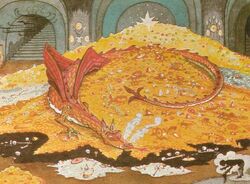
Smaug in the original illustration by J.R.R. Tolkien
In TA 2770, Smaug came from the mountains in the north, drawn by great wealth amassed by the Dwarven kingdom of the Lonely Mountain, which included gold, gemstones, silver, pearls, the many-faceted crystals of emerald, sapphire and diamond, and the famed Arkenstone. He took the mountain, killing many dwarves inside it. Thrór and Thráin used the secret door to escape, and the dragon continued ravaging the surrounding countryside for a long time.
For two centuries, Smaug ruled the Lonely Mountain uncontested, lying within the great treasure hoard of the Lonely Mountain and ensuring no one entered the mountain in an attempt to steal from him. The surrounding domain became a scarred wasteland known to the Dwarves and men as the Desolation of Smaug. Yet in the year TA 2941, a company of fourteen adventurers consisting of twelve Dwarves, the wizard Gandalf, the hobbit Bilbo Baggins, and led by the heir of the Lonely Mountain, Thorin Oakenshield, entered Smaug's mountain lair by a secret door in a daring attempt to reclaim the treasure from the dragon.

Smaug having a conversation with Bilbo Baggins
Bilbo, the company's appointed "burglar," is sent into the treasure chamber alone in an attempt to stealthily gather intel and steal what he can without waking Smaug. Once there, Bilbo is surprised to find that Smaug was much larger than he had expected and covered in impenetrable armor, save for his underbelly. Aware of this vulnerability, Smaug deliberately spent years sprawled on the wealth of his hoard, allowing diamonds and hard gemstones to be embedded into his belly, armoring his only weakness. However, while examining the dragon, Bilbo noticed a single bare patch on the monster's left breast, nearest his heart. With this invaluable information, he escaped the dragon's lair and returns to the Dwarves, sharing his discovery of Smaug's weakness with them, unaware that he was overheard by a thrush, who carried the secret to Bard the Bowman in nearby Esgaroth, also known as Lake-town.
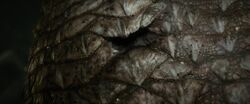
Smaug's previous wound in his scales
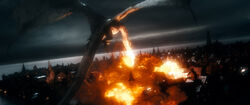
Smaug destroys Lake-town
Returning to the treasure chamber, Bilbo attempts to steal a single cup, but its theft is immediately noted by Smaug, who awakens from his slumber. Amused by the Hobbit, Smaug converses with Bilbo, attempting to deduce his origins and purpose in the mountain. He quickly surmises that Bilbo was aiding Thorin and the rest of the Dwarf company in an attempt to steal back the Arkenstone and reclaim the Mountain. Smaug flies into a rage, erupting from the mountain in a fiery wrath and loosing his flame upon the land. He flies to Lake-town upon the Long Lake and devastates it. In the midst of the wreck, Bard the Bowman, heir to the throne of Dale, does his best to rally men to repel the dragon's assault. Bard, guided by his knowledge of Smaug's secret weakness, fires a black arrow into the beast's vulnerable spot on his belly. Roaring in fury and pain, Smaug falls from the sky and crashes into the flaming ruins of Lake-town, his death signaling the end of the presence of dragons in Middle Earth.
After Death
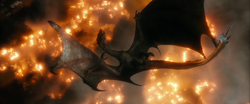
Smaug's body falls upon burning Lake-town.
After Smaug's death, Thorin and Company claimed the treasures of the Lonely Mountain as theirs by birthright. This created a conflict with Bard and the Elvenking Thranduil of Mirkwood, each of whom wanted a portion of the gold as reimbursement for all the damage Smaug had caused their kingdoms over the years. Thorin refused to share the treasure and, as a result, they both declared war on him.
It is said that a vast fortune in gemstones lay with Smaug's rotting carcass amongst the pilings of old Lake-town, but few had the courage to dive for them in later years. With no Dragon to contend with, the survivors of the town rebuilt on dry land next to the lake.
Etymology
The dragon's name, Smaug, derives from the Old English smeag (of or pertaining to a worm), which is related to the past tense of the primitive Germanic verb smugan (to squeeze through a hole). The diphthong "au" in Smaug is pronounced like the "ou" in sound or house, though the name is often erroneously pronounced 'Smog', most notably in the Rankin/Bass animated movie.
Smaug's name in Tolkien's language of Dain, Trâgu, is similar to the Norwegian word for dragon, drágë.
Size
Smaug's actual size is indeterminate as it is never explicitly mentioned in the The Hobbit. In The Atlas of Middle-Earth by Karen Wynn Fonstad[1], Smaug is said to be about 20' meters' (65 feet) in length. This measurement corresponds with drawings by Tolkien in which Smaug seems to be around 25 meters (86 feet). For the size described in the film works, see below.
It is unclear whether Smaug, the largest specimen in the Third Age, would compete in mightiness to his ancestors of average size in the First Age, though he was clearly smaller than Ancalagon, the largest known dragon to have existed.
Abilities
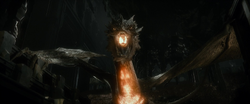
Smaug getting ready to shoot fire at Bilbo.
Being a fully-grown dragon, Smaug was both massive and powerful, possessing physical strength great enough to crush stone with ease, as seen by his attack on the Lonely Mountain. He was able to fly thanks to his large wings, and had the ability to breath streams of searing hot flame from his mouth. Some comments in The Hobbit imply that his entire body was imbued with fire, as he was seen to glow in the darkness of the Lonely Mountain's depths, and his usual paths were said to have been "smoothed and slimed" (i.e. melted) by his passage.
Like many dragons of Middle-earth, Smaug's monstrous appearance also belied keen senses and a dangerously sharp mind. He had an encyclopedic knowledge of his treasure hoard, immediately registering the theft of a single cup after Bilbo made his first visit to his lair. When the hobbit returned a second time, Smaug was already expecting him by feigning sleep, and immediately declared that he could sense the thief even if he could not see him. Although Bilbo was clever enough not to fall for Smaug's attempts to trick him into revealing his exact position, the dragon used the resulting conversation to plant doubts in Bilbo's mind, correctly guessing that the "burglar" had allied himself with the Dwarves and the men of Lake Town and asking if Bilbo had ever considered the logistical difficulties of getting his share of Smaug's treasure back to his home.
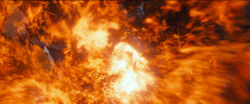
Fire breath, seen in the film
Defensively, Smaug's reddish-gold scales rendered him impervious to nearly all weapons, but his underbelly was relatively soft and vulnerable. To compensate for this, Smaug took to sleeping upon the gathered treasure of the Lonely Mountain, allowing bits of gold and jewels to embed themselves in his body. This "diamond waistcoat" was intended to cover Smaug's only physical weak spot, but when Bilbo Baggins confronted the dragon in his lair, he discovered a bare patch on the left side of his chest. Bard was told this by an ancient thrush that overheard Bilbo relating this information to the Dwarves, enabling him to defeat Smaug by shooting his Black Arrow into the bare patch.
Personality
Smaug is portrayed as being psychopathic, arrogant, and greedy, possessing an unquenchable desire for gold. His most distinguishing characteristic (aside from his greed) is his arrogance, as Smaug proudly boasts of his superiority and impregnability to Bilbo during their encounter. However, this proves to be his downfall, as he unwittingly reveals the weak spot in his chest to Bilbo when showing the Hobbit how he had willfully coated his underbelly in treasure to protect it.
Smaug seems primarily motivated by personal greed rather than a desire to do evil, and does not seem to serve any allegiance other than his own. While he does ruthlessly destroy Dale and lays waste to the Dwarves of the Lonely Mountain during his attack on the Lonely Mountain, once he has assumed dominion of the region he seems content to allow the rest of Middle Earth to go about its business, so long as he or his treasure remains undisturbed; although this could be because he feels that the people living in the region have nothing he wants. Highly intelligent, Smaug appears to possess a rather sardonic sense of humor, darkly mocking Bilbo while they converse within the Lonely Mountain's treasure chamber. Smaug seems to dislike Dwarves, considering them to be weak and pathetic creatures far beneath him, making unfavorable comments about Thror and showing no remorse over his slaughter of their kind and claiming of their kingdom. While conversing with Bilbo, Smaug is also able to quickly surmise the reason for Bilbo's presence in Erebor, and also correctly deduces that the Dwarves received aid from the men of Esgaroth in reaching the mountain.
Portrayal in adaptations
The Hobbit film trilogy
- "I am fire. I am...death."
- —Smaug, Desolation of Smaug
Smaug is voiced and interpreted with performance capture by Benedict Cumberbatch in Peter Jackson's three-part adaptation of The Hobbit. Smaug is presented with a long head, red scales, enormous wings, and gleaming yellow eyes. The dragon has a deep, resonant voice with an underlying growl.
- "I am King under the Mountain."
- —Smaug, Desolation of Smaug
Smaug appears in the prologue of the first film, The Hobbit: An Unexpected Journey, described as a "fire drake from the north" before taking residence in the Lonely Mountain. His full appearance was not shown as only parts of him were glimpsed as he is flying over Dale and partially obscured by the treasure in the Lonely Mountain. He is featured mostly off-screen, only visible are his legs, tail, a small part of his head, and his wings as he flies, which is consistent with Tolkien's illustrations, and his eye, which can be seen in the final scene of the film. In addition, Smaug is a topic of discussion amongst the White Council as Gandalf cites his reason to support Thorin Oakenshield's quest.
When Thorin and Company arrived at the Lonely Mountain and sent their burglar Bilbo Baggins to find the Arkenstone unwittingly cause a landslide that unveiled the dragon. Smaug stirred from his sleep amongst the vast pile of treasure, as he was suspcious that someone was in the chamber with him. Although Bilbo was forced to use his One Ring to keep out of sight from the dragon, Smaug immediately was aware of his presence by his scent (which the smell of Hobbit was unknown to him). He began to search for Bilbo, beckoning him to come out from where he was hiding and when Smaug got too close, the Hobbit was overcome with fear and attempted to run, only to alert the dragon, who gave chase after him through the chamber. Bilbo evaded from him and hides behind a massive pillar, still under the cloak of the Ring. Smaug continued his search, and claimed that he was aware of the Ring in Bilbo's possession and that he sensed that Bilbo has something "made of gold, but far more precious," which in turn forced the hobbit to remove the ring in front of him. Smaug was amused by Bilbo's knowledge of who he was, and began his conversation with the Hobbit in order to deduce his origins.
During their conversation, the Hobbit then tried to lie to Smaug by claiming that he no more but a simple traveler who came to the mountain alone to have a stare of him as he didn't believe the tales about him. The dragon later doubted that flattery would keep him alive and asked who he was and where he came from. Bilbo later made his riddle talk by claiming that he "came from under the hill and over hills and under hills his path had" and through the air he was "he who walks unseen", Smaug hardly believed him but asked Bilbo what also did he claim to be and the Hobbit answered that he was the "luck-wearer", "riddle-maker", and "barrel-rider". The dragon then revealed that he knew that the dwarves were outside of the mountain although Bilbo (whose eyes were on the Arkenstone) tried to deny it, but Smaug did not believe his denies. Soon, a cat-and-mouse banter began with Smaug and Bilbo, as he had been made unfavorable comments about Thrór and boasted about his armor and invincibility. Smaug then realized that Thorin, Thrór's grandson, had sent Bilbo for the Arkenstone and revealed to him, that he founded out Thorin's goal "some time ago" and said that it didn't matter because the quest was ultimately futile as he was aware that Sauron was preparing to openly declare himself once more.
Later on, Smaug tried to take away Bilbo's friendship with Thorin by lying to him that the Dwarf was using him and found his fate worth nothing, but the Hobbit refused to believe him. Smaug was intrigued by his word and wanted to know what reward Thorin was willing to give him if he succeeded in finding the Arkenstone and replied that he would never give away any of treasure, not even a single coin. During the game, Smaug disconcerned of the Hobbit's attempt of stealing the jewel and kept Bilbo from catching the Arkenstone and boasted about his superiority, which the Hobbit would notice the missing scale on his "armored" underbelly, and muttered that one of Girion's Black Arrows did hit one of his scales but later denied it when Smaug asked what Bilbo complemented. Smaug then caught Bilbo's eye on the jewel and claimed that he was almost tempted to let him take it only to let it consume Thorin to madness just like it did to Thrór, though at that point, the dragon then ended the banter with Bilbo and immediately tried to eat him, but Bilbo used his ring to escape and managed to get the Arkenstone while Smaug flew around in rage and unleash a torrent of flames around the treasure chamber in an attempt to roast the Hobbit alive before he can escape.
When Smaug saw Thorin with Bilbo, who pointed his sword at him to see if he found the Arkenstone, the dragon started to charge at him and the other Dwarves who appeared to defend their friends and attempted who charge after them and burn them to death with his fire breath, but they managed to elude him, and Smaug began to silently stalk the abandoned halls in search of them but after the Dwarves avoided him.
Upon realizing he is blocking their only path out of the mountain, the Dwarves hatch a desperate plan to lead Smaug to the Lonely Mountain's forges in hopes that they can trick him into rekindling the smelting vats with his fire breath. They reveal themselves to Smaug, initiating a perilous game of cat an mouse through the halls of the mountain, doing everything in their power to encumber the pursuing dragon as they race towards the entrance to the Lonely Mountain. As Bilbo leads the dragon into the Gallery of the Kings, he is quickly overrun by Smaug, who deduces that Bilbo and the Dwarves were aided by the men of Lake-town, and leaves to destroy the town. As he is leaving, Thorin appears and taunts him, unveiling an enormous, freshly casted golden statue of a dwarf, which distracts the greedy dragon long enough for the statue to melt into liquid gold and engulf him. However, Smaug survives the scalding gold and erupts from the molten pool, roaring that he will show the Dwarves what revenge really is. He then breaks through the walls of the mountain, shakes off his gold coating, and takes flight. Smaug flies off towards Lake-town, and the film ends with him uttering "I am Fire, I am.....Death!" as he soars towards the unsuspecting town, leaving Bilbo and the others in horror at what they have unleashed.
In the opening of the third film, The Hobbit: The Battle of the Five Armies, Smaug, after reaching Lake-town, proceeds to destroy the city for their part in aiding the Dwarves. Bard, having escaped imprisonment from the Master of Laketown, climbs atop the belltower and tries to shoot Smaug with arrows, though each attempt fails, harmlessly bouncing off Smaug's armor. Eventually, Bain, Bard's son, arrives to aid his father with a Black Arrow. Unfortunately, as Smaug flies over, he claws at the tower. With the tower now being half-destroyed, Bard is forced to make a makeshift crossbow using a rope that held bell, some pieces of broken wood, and Bain as a stand. Smaug lands, and looks towards Bard, sneering at his attempts to stop him. Ignoring this, Bard notches the arrow, while Smaug charges him and his son. Bard fires his arrow, which hits Smaug straight in the chest on his weak spot. The dragon stumbles, knocking Bard and Bain off their perch, before flying back up. Clawing and biting at the sky, his internal glow fades as he dies in mid-air. Smaug's body, upon falling to the water, lands on Laketown's corrupt master, killing him.
Even after his death, Smaug's influence is felt throughout the movie. Aside from the damage he inflicted on Lake-Town driving the residents to try and stay in Dale, as Thorin falls under the influence of the dragon sickness, Bilbo begins to hear him speak in Smaug's voice, and Thorin experiences a hallucination of Smaug while walking on the golden floor that they created while trying to 'drown' the dragon.
The dragon was created with key frame animation, meaning it was animated by hand, in addition to Cumberbatch's motion capture performance. Weta Digital employed its proprietary "Tissue" software which was honored in 2013 with a "Scientific and Engineering Award" from the Academy of Motion Picture Arts and Sciences to make the dragon as realistic as possible. Cumberbatch aimed for Smaug's voice to be "that bridge between animal and human, something guttural, deep and rasped, kind of dry as well because of all the fire breathing." He studied reptiles at the London Zoo to prepare for the role.
Smaug was considered the highlight of the second film of the series with several critics hailing it as cinema's greatest dragon incarnation. Universal praise was also given to the visual effects company Weta Digital and the vocal and motion-capture performance of Cumberbatch for bringing a fully realized personality to Smaug.
Movie Personality
While his personality is more or less the same as the book, in the movie, Smaug is considerably more malicious and cruel than in the book. He takes much more pleasure in psychologically tormenting Bilbo, choosing to spare him just so that Bilbo can watch Laketown burn, and sarcastically asking him how he would like to die. During his attack on Laketown, Smaug went out of his way to mock and sneer at Bard and Bain. He was also aware of the return of Sauron, and was apparently intent on joining forces with him. Like his book counterpart, Smaug is quite arrogant, and the mere implication that he may possess a weakness made him visibly angry.
Movie Abilities
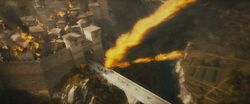
Smaug's liquid-flame in the first film.
, It is possible that he can change how his fire-breath comes out, depending on the usages. In the first film, his fire was more liquid and napalm-like, which had enough power and mass to shatter stone buildings and its blast could spread on the ground. In the second film, his fire is somewhat of a more typical fire or gas-fueled flamethrower-like with immense firepower enough to engulf his own body. It is possible that his breath in the second movie was normal fire because his priority was to kill the intruders, and not to cause destruction, understandably his treasures as well as risk having the mountain fall down on him. Likewise since most of Lake-Town consist of wood as oppose to the stone buildings of Dale, Smaug wouldn't need to rely on his flames to cause destruction but just watch it spread. Even with that limitation, though, his single breath was enough to re-ignite the great forges of Erebor.
His large size is shown to grant him amazing brute strength, sufficient for him to easily break through the mountain. His armored skin is shown to be nearly impenetrable and his natural endurance for heat is demonstrated by being able to survive being submerged in molten gold. As his stamina is very high, he's able to move fast enough to fly since surviving the melting gold. His senses are good enough that he was able to detect the sound and smell of a Hobbit even when the ring rendered Bilbo invisible to the eye. It is show that his roar is powerful enough to be heard in the village. He was as intelligent as any man, if not more so, and he is able to communicate with people. Visually, Smaug is shown to glow with red light from within when he is about to unleash his fiery breath, same red light emanating from his eyes, only dimming at the moment of the dragon's death. In addition, his sense of gold is shown so great that he managed to feel the One Ring carried by Bilbo, describing it as "something made of gold, but far more... precious".
Movie Size and Appearance
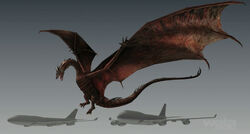
Smaug's size comparison with Boeing 747 in making.
In the film adaptations, Smaug dramatically increased in size. His actual size was unknown until his image designed on Air New Zealand B777 was revealed to be 54 meters in length. However, this was the length of painting itself, not his actual size. There is estimations of him to be longer than 60 meters in length and wider than 50 meters in wingspan based on comparison with the dwarf coins[2]. Though in the comments made in the makings, his size is mentioned to be 130 meters in length and "bigger than two jumbo jets"[3].
- In original concepts, Smaug was supposed to be more menacing and gigantic, and serpentine than in the actual movie, and these changes were due to make its character more 'special'. The same trait happened with Gollum as well[4]. In pre-publishing comments by Joe Letteri, the Oscar winning VFX supervisor from Weta digital, Smaug was said to be "twice as big as a Boeing 747", calculating over 141m in length[5].
Film Continuity
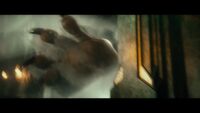
Smaug's "foreleg" seen in the first film by ArchedCory.
In the prologue of the theatrical release of An Unexpected Journey, Smaug had six limbs (four legs and two wings), which was his initial design, before it was changed for the next film, where the Dragon is revealed as having four limbs (two back legs and two front legs with his wings attached). Additionally, several scene captures revealed that his scale was seen to be in blue coloring at the very end of the film for unknown reasons.
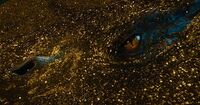
Smaug under his treasure with his scales in blue color.
The film also deviates from the book in portraying Smaug's underbelly as being heavily armored as the rest of him, rather than being artificially protected by a coat of gold and gems. The bare patch that Bilbo notices is a single missing scale instead, broken off during his attack on Dale, by one of the Black Arrows fired by Girion.
Unlike in the books, Smaug gives no mention to his tail or fiery breath during his speech to Bilbo, nor does he use either to smash the mountainside before he flies to Laketown, although he does breathe fire during the battle with the Dwarves.
In Gene Deitch's version (1966)

Slag the ancient monster.
Smaug in this version was mentioned to be 'Slag', 'the ancient monster of the Earth'.
The monster has a tail which can pick a object. He was slain by Bilbo, Thorin's company, and 'Princess Mika' (an original character who was one of three survivors from Elebor and Esgaroth along with Thorin) very themselves, by shooting a large arrow which the heart-shaped Arkenstone was attached with as an arrowhead, from a catapult.
Rankin/Bass' The Hobbit
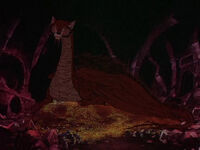
Smaug in the Rankin and Bass animated version from 1977.
In the 1977 animated version of The Hobbit, Smaug was voiced by Richard Boone, and his head looked wolf-like.
Video games
- In the 2003 video game release, Smaug was voiced by James Horan. His role in the game is paralleled to the book, wherein he took over the dwarf kingdom and killing all who dare enter with a swift blow of his devastating fire attacks. The gameplay consists :
- Smaug usually lies in the center of the room while Bilbo quietly navigates around him not to startle his detection meter.
- A cutscenes shows Smaug asking Bilbo who he is and appears to use language effectively.
- Bilbo gathers information about Smaug and his one vulnerability under his side where jewels do not protect him, he later tells the dwarves about what he discovered.
- Smaug also appears in the Lego video game of LEGO The Hobbit, which was released on 11th of April 2014.
Voice Dubbing actors
| Foreign Language | Voice dubbing artist |
|---|---|
| Portuguese (Brazil) (Television/DVD) | Ricardo Schnetzer |
| Spanish (Latin America) | Carlos Segundo |
| Spanish (Spain) | Ivan Muelas |
| Italian (Italy) | Luca Ward |
| Hungarian | Peter Haas Vander |
| Czech | Aleš Procházka |
| French | Jérémie Covillault |
| German | Sascha Rotermund |
| Polish (Poland) | Jacek Mikołajczak |
Translations around the World
| Foreign Language | Translated name |
|---|---|
| Chinese (Hong Kong) | 史矛革 |
Trivia

Six limbed Smaug in original concept.
- Most notably, Smaug was apparently a four-legged western dragon in the first film[6], but to follow the description in the book, referring to him as a "worm", he was redesigned to be a more snake or bird like wyvern-type dragon in the second film[7]. In the Blu-ray extended edition of the first movie, his forelimbs were changed to winged-arms[8]. Many other of his body parts have also been altered from what he looked like in the first movie[9].
- Smaug in the movie was designed to be 'multicultural', combining characteristics from dragons around the world[12].
- A kite resembling Smaug appears in the prologue of the first film.
- Some of his early designs largely resembles that of the Balrog in the movie series, as one has horns and bulk neck resembling that of Balrogs, and his eyes and inside of mouth glow incandescent white like a jack O'lantern in another one.
- Smaug in the movie was somehow aware of Black Arrows with their proper noun.
- Smaug is one of regular rankers in the "Richest fictional characters" by the Forbes. According to Michael Noer, writing for Forbes Magazine, Smaug is the wealthiest fictional character, with a treasure having a calculated valuation of over 62 billion dollars[13]
- In the movie, Smaug seems to have a will of Dominance, as he was shown capable of forcing Bilbo into revealing himself.
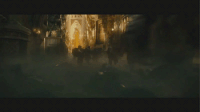
Smaug's forelegs seen in the first film.(gif)
- It is quite possible that Gandalf wanted Smaug to be destroyed before the War of the Ring began, because had Smaug allied with Sauron, it would have meant almost certain ruin for the Free Peoples -- the forces of Rohan and Gondor would not have been able to bring him down without suffering enormous losses. This idea is reinforced in the extended version of An Unexpected Journey when Gandalf meets with the White Council at Rivendell, as he expresses concern at the possibility of Smaug allying with the new darkness that Radagast has encountered (Although Saruman dismisses this as nothing more than some human playing with black magic rather than recognizing it as Sauron).
- The extended edition of the Desolation confirms Gandalf's fear of Smaug and Sauron working together as Thrain reveals. This explains his vast knowledge of Sauron and the Ring as he alludes in the theatrical version. Precisely why he would join the Dark Lord is unclear, but it is possible that despite his strength, he does not have the power to fight Sauron.
Gallery
See here: Smaug/Image Gallery
References
- ↑ Karen Wynn Fonstad, 2002, The Atlas of Middle-Earth, Houghton Mifflin
- ↑ http://www.theonering.net/torwp/2013/05/11/71530-analysis-just-how-big-is-jacksons-smaug/3/
- ↑ Ian Failes. 2014. Behind the scenes of Weta Digital’s Smaug. the fxguide. Retrieved on December 08. 2014
- ↑ http://www.mtv.com/news/articles/1719502/smaug-hobbit-fx-explained.jhtml
- ↑ Giardina C.. 2013. 'The Desolation of Smaug:' Weta's Joe Letteri Reveals The Biggest VFX Challenges. The Hollywood Reporter. Retrieved on December 08. 2014
- ↑ http://thorinoakenshield.net/2013/12/24/the-anatomy-of-smaug/
- ↑ http://atolkienistperspective.wordpress.com/2013/11/13/dragons-vs-wyverns-the-question-of-smaug/
- ↑ http://atolkienistperspective.wordpress.com/2013/11/13/dragons-vs-wyverns-the-question-of-smaug/
- ↑ Kelvarhin. 2013. What Smaug might look like – a concept. TheOneRing.net. Retrieved on December 08. 2014
- ↑ Hill K.. 2014. Smaug Breathes Fire Like A Bloated Bombardier Beetle With Flinted Teeth. The Scientific American. Retrieved on December 08. 2014
- ↑ Sullivan P.K.. 2013. What Happened To Smaug’s Other Legs? ‘Hobbit’ FX Expert Explains. The Mtv News. Retrieved on December 08. 2014
- ↑ http://www.mtv.com/news/articles/1719502/smaug-hobbit-fx-explained.jhtml
- ↑ Noer,Michael. (23 April 2012). How much is a dragon worth: Revisited. Forbes.com. Forbes. Retrieved from: [http://www.forbes.com/sites/michaelnoer/2012/04/23/how-much-is-a-dragon-worth-revisited/.
External links
 Smaug at Tolkien Gateway
Smaug at Tolkien Gateway- Anatomy of Smaug by ArchedCory
